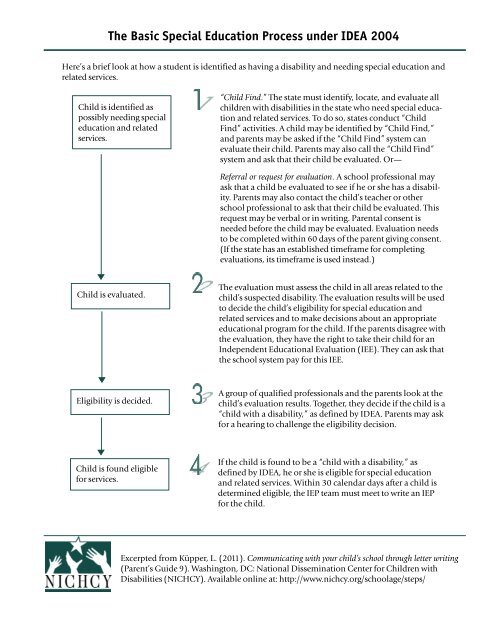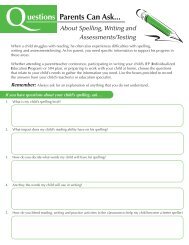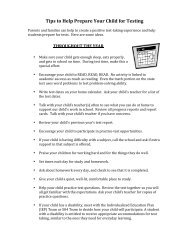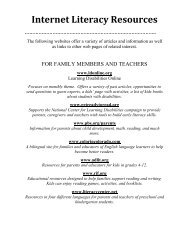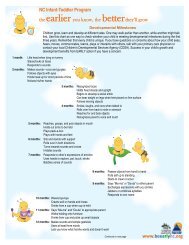The Basic Special Education Process under IDEA 2004 (cont.) - nichcy
The Basic Special Education Process under IDEA 2004 (cont.) - nichcy
The Basic Special Education Process under IDEA 2004 (cont.) - nichcy
You also want an ePaper? Increase the reach of your titles
YUMPU automatically turns print PDFs into web optimized ePapers that Google loves.
<strong>The</strong> <strong>Basic</strong> <strong>Special</strong> <strong>Education</strong> <strong>Process</strong> <strong>under</strong> <strong>IDEA</strong> <strong>2004</strong><br />
Here’s a brief look at how a student is identified as having a disability and needing special education and<br />
related services.<br />
Child is identified as<br />
possibly needing special<br />
education and related<br />
services.<br />
“Child Find.” <strong>The</strong> state must identify, locate, and evaluate all<br />
children with disabilities in the state who need special education<br />
and related services. To do so, states conduct “Child<br />
Find” activities. A child may be identified by “Child Find,”<br />
and parents may be asked if the “Child Find” system can<br />
evaluate their child. Parents may also call the “Child Find”<br />
system and ask that their child be evaluated. Or—<br />
Referral or request for evaluation. A school professional may<br />
ask that a child be evaluated to see if he or she has a disability.<br />
Parents may also <strong>cont</strong>act the child’s teacher or other<br />
school professional to ask that their child be evaluated. This<br />
request may be verbal or in writing. Parental consent is<br />
needed before the child may be evaluated. Evaluation needs<br />
to be completed within 60 days of the parent giving consent.<br />
(If the state has an established timeframe for completing<br />
evaluations, its timeframe is used instead.)<br />
Child is evaluated.<br />
<strong>The</strong> evaluation must assess the child in all areas related to the<br />
child’s suspected disability. <strong>The</strong> evaluation results will be used<br />
to decide the child’s eligibility for special education and<br />
related services and to make decisions about an appropriate<br />
educational program for the child. If the parents disagree with<br />
the evaluation, they have the right to take their child for an<br />
Independent <strong>Education</strong>al Evaluation (IEE). <strong>The</strong>y can ask that<br />
the school system pay for this IEE.<br />
Eligibility is decided.<br />
A group of qualified professionals and the parents look at the<br />
child’s evaluation results. Together, they decide if the child is a<br />
“child with a disability,” as defined by <strong>IDEA</strong>. Parents may ask<br />
for a hearing to challenge the eligibility decision.<br />
Child is found eligible<br />
for services.<br />
If the child is found to be a “child with a disability,” as<br />
defined by <strong>IDEA</strong>, he or she is eligible for special education<br />
and related services. Within 30 calendar days after a child is<br />
determined eligible, the IEP team must meet to write an IEP<br />
for the child.<br />
Excerpted from Küpper, L. (2011). Communicating with your child’s school through letter writing<br />
(Parent’s Guide 9). Washington, DC: National Dissemination Center for Children with<br />
Disabilities (NICHCY). Available online at: http://www.<strong>nichcy</strong>.org/schoolage/steps/
<strong>The</strong> <strong>Basic</strong> <strong>Special</strong> <strong>Education</strong> <strong>Process</strong> <strong>under</strong> <strong>IDEA</strong> <strong>2004</strong> (<strong>cont</strong>.)<br />
Once the student has been found eligible for services, the IEP must be written. <strong>The</strong> two steps below<br />
summarize what is involved in writing the IEP.<br />
IEP meeting is scheduled.<br />
<strong>The</strong> school system schedules and conducts the IEP meeting.<br />
School staff must:<br />
• <strong>cont</strong>act the participants, including the parents;<br />
• notify parents early enough to make sure they have an<br />
opportunity to attend;<br />
• schedule the meeting at a time and place agreeable to<br />
parents and the school;<br />
• tell the parents the purpose, time, and location of the<br />
meeting;<br />
• tell the parents who will be attending; and<br />
• tell the parents that they may invite people to the meeting<br />
who have knowledge or special expertise about the child.<br />
IEP meeting is held<br />
and the IEP is written.<br />
<strong>The</strong> IEP team gathers to talk about the child’s needs and write<br />
the student’s IEP. Parents and the student (when appropriate)<br />
are part of the team. If the child’s placement is decided by a<br />
different group, the parents must be part of that group as well.<br />
Before the school system may provide special education and<br />
related services to the child for the first time, the parents must<br />
give consent. <strong>The</strong> child begins to receive services as soon as<br />
possible after the IEP is written and this consent is given.<br />
If the parents do not agree with the IEP and placement, they<br />
may discuss their concerns with other members of the IEP<br />
team and try to work out an agreement. If they still disagree,<br />
parents can ask for mediation, or the school may offer mediation.<br />
Parents may file a complaint with the state education<br />
agency and may request a due process hearing, at which time<br />
mediation must be available.<br />
Excerpted from Küpper, L. (2011). Communicating with your child’s school through letter writing<br />
(Parent’s Guide 9). Washington, DC: National Dissemination Center for Children with<br />
Disabilities (NICHCY). Available online at: http://www.<strong>nichcy</strong>.org/schoolage/steps/
<strong>The</strong> <strong>Basic</strong> <strong>Special</strong> <strong>Education</strong> <strong>Process</strong> <strong>under</strong> <strong>IDEA</strong> <strong>2004</strong> (<strong>cont</strong>.)<br />
Here is a brief summary of what happens after the IEP is written.<br />
Services are provided.<br />
<strong>The</strong> school makes sure that the child’s IEP is being carried out<br />
as it was written. Parents are given a copy of the IEP. Each of<br />
the child’s teachers and service providers has access to the IEP<br />
and knows his or her specific responsibilities for carrying out<br />
the IEP. This includes the accommodations, modifications,<br />
and supports that must be provided to the child, in keeping<br />
with the IEP.<br />
Progress is measured and<br />
reported to parents.<br />
<strong>The</strong> child’s progress toward the annual goals is measured, as<br />
stated in the IEP. His or her parents are periodically informed<br />
of their child’s progress toward achieving the annual goals<br />
(such as through the use of quarterly or other periodic<br />
reports, perhaps issued at the same time as report cards).<br />
IEP is reviewed.<br />
<strong>The</strong> child’s IEP is reviewed by the IEP team at least once a<br />
year, or more often if the parents or school ask for a review. If<br />
necessary, the IEP is revised. Parents, as team members, must<br />
be invited to attend these meetings. Parents can make suggestions<br />
for changes, can agree or disagree with the IEP goals,<br />
and agree or disagree with the placement.<br />
If parents do not agree with the IEP and placement, they may<br />
discuss their concerns with other members of the IEP team<br />
and try to work out an agreement. <strong>The</strong>re are several options,<br />
including additional testing, an independent evaluation, or<br />
asking for mediation or a due process hearing. <strong>The</strong>y may also<br />
file a complaint with the state education agency.<br />
Child is reevaluated.<br />
At least every three years the child must be reevaluated, unless<br />
parents and the school system agree that a reevaluation is not<br />
necessary. <strong>The</strong> purpose of the reevaluation is to find out if the<br />
child <strong>cont</strong>inues to be a “child with a disability,” as defined by<br />
<strong>IDEA</strong>, and what the child’s educational needs are. Parents<br />
must give their consent for their child’s reevaluation.<br />
A child may be reevaluated more often if conditions warrant<br />
or if the child’s parent or teacher asks for a new evaluation.<br />
NICHCY<br />
1825 Connecticut Avenue N.W.,<br />
Suite 700<br />
Washington, DC 20009<br />
1.800.695.0285 (Voice / TTY)<br />
202.884.8200 (Voice / TTY)<br />
<strong>nichcy</strong>@aed.org<br />
www.<strong>nichcy</strong>.org


